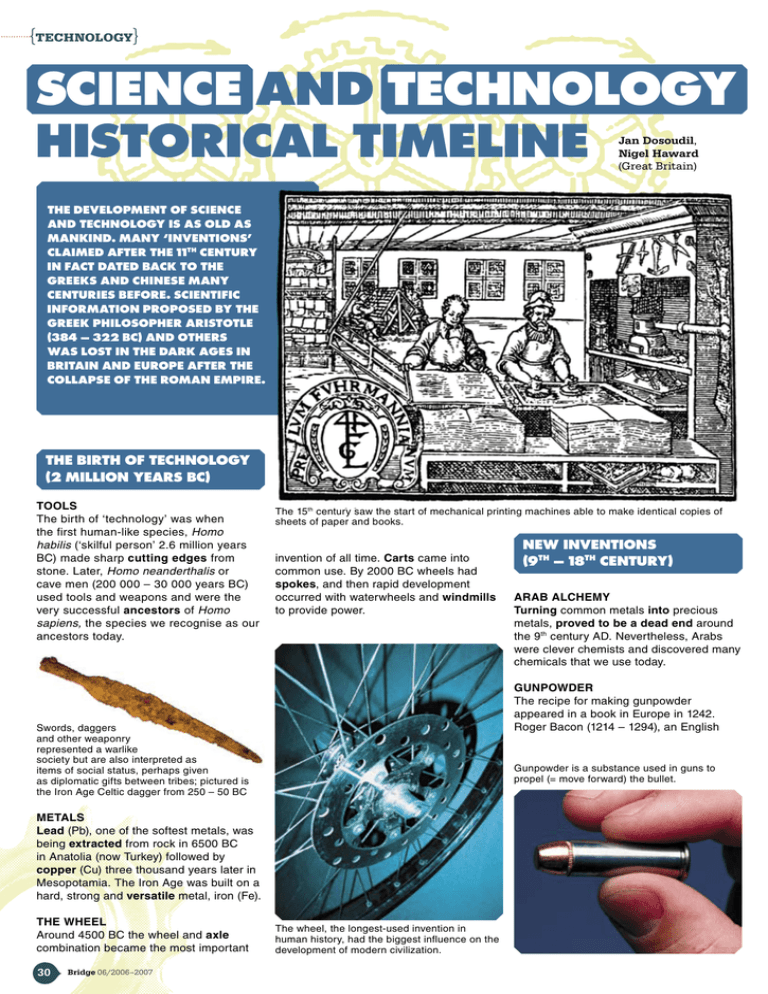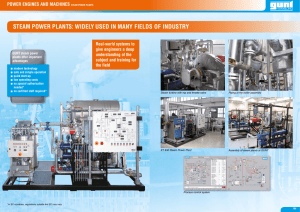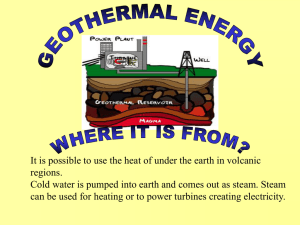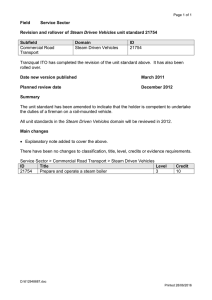Science & Technology History Timeline
advertisement

{technology}
Science and technology
historical timeline
Jan Dosoudil,
Nigel Haward
(Great Britain)
the development of Science
and technology is as old as
mankind. Many ‘inventions’
claimed after the 11th century
in fact dated back to the
Greeks and Chinese many
centuries before. Scientific
information proposed by the
Greek philosopher Aristotle
(384 – 322 BC) and others
was lost in the Dark Ages in
Britain and Europe after the
collapse of the Roman empire.
The birth of technology
(2 million years BC)
Tools
The birth of ‘technology’ was when
the first human-like species, Homo
habilis (‘skilful person’ 2.6 million years
BC) made sharp cutting edges from
stone. Later, Homo neanderthalis or
cave men (200 000 – 30 000 years BC)
used tools and weapons and were the
very successful ancestors of Homo
sapiens, the species we recognise as our
ancestors today.
The 15th century saw the start of mechanical printing machines able to make identical copies of
sheets of paper and books.
invention of all time. Carts came into
common use. By 2000 BC wheels had
spokes, and then rapid development
occurred with waterwheels and windmills
to provide power.
Gunpowder is a substance used in guns to
propel (= move forward) the bullet.
Metals
Lead (Pb), one of the softest metals, was
being extracted from rock in 6500 BC
in Anatolia (now Turkey) followed by
copper (Cu) three thousand years later in
Mesopotamia. The Iron Age was built on a
hard, strong and versatile metal, iron (Fe).
30
Bridge 06/2006–2007
Arab alchemy
Turning common metals into precious
metals, proved to be a dead end around
the 9th century AD. Nevertheless, Arabs
were clever chemists and discovered many
chemicals that we use today.
Gunpowder
The recipe for making gunpowder
appeared in a book in Europe in 1242.
Roger Bacon (1214 – 1294), an English
Swords, daggers
and other weaponry
represented a warlike
society but are also interpreted as
items of social status, perhaps given
as diplomatic gifts between tribes; pictured is
the Iron Age Celtic dagger from 250 – 50 BC
The wheel
Around 4500 BC the wheel and axle
combination became the most important
New inventions
(9th – 18th century)
The wheel, the longest-used invention in
human history, had the biggest influence on the
development of modern civilization.
friar and philosopher, was the first to
describe its formula. Guns soon followed.
Printing
Spreading knowledge and information was
a very slow process before the invention
of typography. Johannes Gutenberg (1398
– 1468) developed the first mechanical
printing machine in the 1440s. The first
printed book was the Bible in 1456 with
a run of 150 copies. Each Bible previously
took three years to make by hand.
The telescope
The telescope was invented by Dutchman
Hans Lippershey (1570 – 1619). In 1610,
using his improved design, Galileo Galilei
(1564 - 1642) was able to prove that
the Earth revolved around the Sun.
This confirmed the ideas of the Polish
astronomer Nicolaus Copernicus (1473
– 1543) but it angered the Catholic Church
who had adopted the idea that the Earth
was at the centre of everything.
Steam engines enabled the development
of pumps, locomotives, steam ships, steam
lorries, etc.
Lightning conductor, Nieuwe Kerk (New
Church), Delf, Holland
and scientist proved that lightning was a
form of electricity when he flew a kite in
a thunderstorm. Around 1754, Franklin
and the Czech scientist, Prokop Diviš
(1698 - 1765) independently developed
the lighting conductor to protect buildings
from being hit and damaged by lighting.
recognised as the inventor of the steam
engine in 1765. Water could be pumped
out of mines and industrial processes
speeded up.
George Stephenson’s (1781 - 1848)
Rocket was the first locomotive to pull
heavy loads a long distance. This
led to the rapid expansion of railways
throughout Britain and the world. The
combination of iron and steam paved the
way for the great Victorian engineering
projects of Isambard Kingdom Brunel
(1806 - 1859). He designed bridges,
tunnels, viaducts and ships.
Rocket locomotive
The first Industrial
Revolution (1760 – 1840)
Steam power
This era saw the development of steam
engines to power factory machinery.
Heating water in a boiler to make steam to
power a vehicle was a major technological
advance. James Watt (1736 – 1819) is
Photography
In 1826, after years of experiments,
the French inventor Joseph Nicéphore
Niépce (1765 - 1833), using ‘bitumen of
Judea’ spread on a pewter plate and an
exposure of eight hours in bright sunlight,
produced the first permanent picture.
His technique was improved upon by his
colleague Louis Daguerre (1787 - 1851) by
using compounds of silver, the basis of
modern photography.
The Harlan J. Smith Telescope, McDonald
Observatory in Fort Davis (USA). Founded in
1932, it is the observatory of the University of
Texas and operates six telescopes.
The microscope
Looking at small things became possible
when a Dutch maker of spectacles, Hans
Janssen and his son, put glass lenses
together in 1590 to make a primitive
microscope. Anton van Leeuwenhoek
(1632 – 1723) took this invention a step
further in 1676 with a magnification
of 270 times and discovered tiny
single-celled creatures in pond water.
Ultimately, this helped our understanding
of microorganisms and disease.
Lightning conductor
In 1752, Benjamin Franklin (1706 –1790),
the American statesman, philosopher
Already in the 16th century, a device called
“camera obscura” was able to project images
on a board, however, it wasn’t able to capture
permanent images.
A microscope is an instrument for viewing
objects that are too small to be seen by
the unaided eye. Today, there are electron
miscroscopes, using magnetic fields and
electron rays instead of lenses and light,
making it possible to see even atoms.
Bridge 06/2006–2007
31
{technology}
The second Industrial
Revolution
(19th century – 1945)
The electric light
After many refinements, Thomas Edison’s
(1847 – 1931) electric light bulbs were
the best and by 1879 they would last for
hundreds of hours, much longer than any
of their rivals. They were also cheap. To
sell bulbs, energy was needed, so Edison’s
Electric Illumination Company built their
own power station in New York. After
many decades he successfully persuaded
the public to opt for clean, convenient
electric light rather than gas lights.
In 1888, George Eastman (pictured on the left) registered the trademark Kodak, (which
was simply a combination of some of his favourite letters), long known for its wide range of
photographic film products.
on the other side of the world. Admittedly,
it was initially from one room to another.
The message was “Mr. Watson, come
here, I want you”. A year later in 1877 he
set up his company and demonstrated
long distance calls.
Edison made his first lightbulbs from bamboo
fibres.
The motor car
Until the 1860s all prototype motor cars
were steam driven. German inventor
Nicolas Otto (1832 - 1891) created an
improved internal combustion engine
in 1876 and this is still the way cars work
today. In 1885, the first car, the Benz
Patent Motorwagen, was developed by
Karl Benz (1844 - 1929). It was a long
time before cars became common. Petrol,
a cleaning fluid, was only available from
the chemist. Famous names such as Rolls
Royce and Henry Ford developed the
technology; Rolls Royce for the rich and
Henry Ford for the man in the street.
The movies
It has been only just over one hundred
years since the first movie, or film, was
shown by the brothers Auguste and Louis
Lumière (1862 - 1954 and 1864 - 1948)
in 1895 at the Grand Café in Paris. The
terrifying film was entitled The Arrival of
a Train at Ciotat Station. Surprisingly,
the brothers decided that films didn’t
have much of a future and went back to
photography. In 1889, George Eastman
(1854 - 1932) pioneered celluloid film
with holes punched in the side so that
the movie camera could show the film
precisely frame by frame.
The telephone
This is an invention that made money.
Alexander Graham Bell (1847 – 1922) was Replica of the Benz Patent Motorwagen built
the first in the race to patent a machine in in 1885
1876 that you could use to talk to someone
Pioneer Village Telephone Office
X-rays were quickly adapted for their use
in medicine. They are especially useful in
examining the skeletal system, but they can also
identify other diseases, for example pneumonia
and lung cancer.
X-rays
Science is impressive when something is
discovered that cannot be seen. German
physicist Wilhelm Rontgen (1845 – 1923)
working with electrical discharges in
glass tubes noticed in 1895 that there
was a faint glow on a nearby screen.
These rays were invisible and could
32
Bridge 06/2006–2007
Rockets and space flights
The earliest rockets were used in
China in the 11th century but by the
19 th century speed and accuracy were
much improved. Knowledge of astronomy
meant that scientists knew the relative
movements of the planets in relation to
the Earth. A Russian mathematics teacher,
Konstantin Tsiolkovsky (1857 – 1935), was
the first person to draw up plans for space
stations and air locks to allow space walks.
He correctly calculated that a rocket would
have to travel at 8 km per second to leave
the atmosphere and that liquid rocket
fuel would be essential. American scientist
Robert Goddard (1882 – 1945) not knowing
of Tsiolkovsky’s ideas, independently
developed liquid fuelled rockets from 1926.
Ultimately, NASA took up the challenge
but the Russians eventually won the race
to put a man into orbit. Yuri Gagarin
(1934 – 1968) orbited the earth in 1961.
In the US, NASA scientists redressed the
balance in the space race with their
moon landing in 1969.
pass through most materials. He also
recorded them on photographic paper and
thus the first X-ray image was developed.
He quickly realised the medical potential
of his discovery. Henri Becquerel
(1852 – 1908) discovered radioactivity
in 1896 while trying to find more out
about X-rays. Marie Curie (1867 – 1934),
a Polish born French chemist and physicist
and two times Nobel Prize winner, is
best remembered for her research into
radioactivity and new radioactive elements.
Morse code uses short and long elements
(known as “dots” and “dashes”) to transmit
information. Originally created for an electric
telegraph, it was often used for early radio
communication.
Communications
Radio waves travel in all directions at an
incredible 300 000 km per second. The
German physicist Heinrich Hertz (1857 –
1854) was the first to prove they existed
but it was Guglielmo Marconi (1874 – 1937)
who set up the world’s first radio stations
to transmit and receive Morse code. In
1896, he sent the first message across the
Atlantic from Cornwall to Newfoundland. He
was awarded the Nobel Prize for Physics in
1909. It was not until 1915 that engineers
were able to transmit sound effectively.
The first clear television pictures to be
transmitted were sent by Scottish-born John
Logie Baird (1888 – 1946). He founded the
Baird Television Company Limited and
worked on programmes
for the BBC (British
Broadcasting
Corporation).
The Proton rocket is a type of Russian space
vehicle. It was first launched in 1965 and it is
still used today, which makes it one of the most
successful rockets in the history of space flight.
The cloud of smoke and flame produced by
a nuclear explosion is called a “mushroom
cloud” because of its typical shape.
Model of the Wright brothers’ airplane
Flight
At the turn of the century, in 1903, two bicycle repairmen from Ohio, Wilbur and Orville
Wright (1867 – 1912 and 1871 – 1948) built and flew the first really successful aeroplane
near Kitty Hawk, North Carolina. From that time progress was rapid and the military
advantages of flight were realised in WWI.
The atomic bomb
Science and technological advances can
be seen as good or bad. The invention
of gunpowder must have seemed like
that. In 1932, physicists John Cockcroft
(1897 – 1967) and Earnest Walton
(1903 – 1995) did the impossible. They
split the atom. They proved Albert
Einstein’s (1879 – 1955) theory of relativity
(E=mc²) and unlocked the secrets of the
atomic nucleus. Splitting the atom was
a brilliant scientific achievement. However,
having that knowledge allowed scientists
to develop the atomic bomb. The use of an
atomic bomb on Hiroshima and Nagasaki
in Japan to end the WWII in 1945 was
a political decision that was highly
controversial. We now know that there
is no turning back once scientific and
technological discoveries have been made.
Bridge 06/2006–2007
33
{technology}
The third
Scientific‑Technical
Revolution (1945 - )
After the WWII new discoveries and
advances in science and technology came
thick and fast. Plastics were developed
for the first time. In 1949, the first practical
programmed electronic computer ran
mathematical problems. It fitted into one
room! In the 1960s, the electronic silicon
chip was invented, computers became
smaller and more powerful.
In 1984, the CD was born
and the digital revolution
began. The worldwide
web has given us access
to billions of documents
with information and
images as well as
online shopping
and banking.
Mobile
telephone
In the beginning,
computers were mostly
used for mathematical
operations.
Y Vocabulary
cutting edge [EdZ] - ostří
ancestor ["&nsEst@] - předek, předchůdce
lead [lEd] - olovo
to extract [Ik"str&kt] - získat
copper ["kQp@] - měď
versatile ["v@:s@taIl] - univerzálně použitelný
axle ["&ks(@)l] - náprava
cart [kA:t] - vůz
spokes [sp@Uks] - paprsky kola
windmill ["wIn(d)mIl] - větrný mlýn
alchemy ["&lkImi] - alchymie
turning... into - přeměna... na
proved to be a dead end [pru:vd] - se ukázala jako
slepá ulička
gunpowder ["gVnpaUd@] - střelný prach
friar ["fraI@] - mnich
formula ["fO:mjUl@] - složení
with a run of... copies - v nákladu... výtisků
to revolve around [rI"vQlv] - točit se kolem
to confirm [k@n"f@:m] - potvrdit
to anger ["&Ng@] - rozhněvat
spectacles ["spEkt@k(@)lz] - brýle
lens [lEnz] - čočka
took this invention a step further... with a magnification
of 270 times [In"vEnS(@)n "f@:D@ m&gnIfI"keIS(@)
n] - dotáhl tenhle vynález ještě o krok dál... když dosáhl
270-tinásobného zvětšení
tiny single-celled creatures in pond water [sEld
"kri:tS@z pQnd] - droboučké jednobuněčné organismy
v rybniční vodě
ultimately ["VltIm@tlI] - nakonec
lightning conductor ["laItnIN k@n"dVkt@] - bleskosvod
lightning - blesk
kite [kaIt] - papírový drak
thunderstorm ["TVnd@stO:m] - bouře
independently [IndI"pEnd(@)ntlI] - nezávisle na sobě
steam engine [sti:m "EndZIn] - parní stroj
34
Bridge 06/2006–2007
DNA contains the genetic information for the
reproduction of life.
technology means we have instant
contact with friends and family.
During this period,
there have also been huge
advances in genetics
since the discovery of the
structure of DNA in 1953.
Today, Biotechnology
and genetic engineering
show fast growth trends
and, also, are big
business.
It is interesting to
wonder what next? Maybe
space is the final frontier, as
suggested in Star Trek!
The first electro‑mechanical computer
was built in the USA in 1946 by Eckert
and Mauchly.
to power ["paU@] - pohánět
advance [@d"vA:ns] - pokrok
mine [maIn] - důl
to speed up - zrychlit
load [l@Ud] - náklad
paved the way for - připravila cestu
spread on a pewter plate ["pju:t@ pleIt]
- rozetřený po cínové desce
exposure [Ik"sp@UZ@] - doba expozice
compounds of silver ["kQmpaUndz "sIlv@]
- sloučeniny stříbra
refinement [rI"faInm(@)nt] - vylepšení, zdokonalení
bulb [bVlb] - žárovka
power station ["paU@ "steIS(@)n] - elektrárna
persuaded the public to opt [p@"sweIdId Qpt]
- přesvědčil veřejnost, aby dala přednost
gas - plynový
in the race to patent ["peIt(@)nt] - v závodě o to,
kdo si dřív nechá patentovat
admittedly [@d"mItdli] - je pravda, že
initially [I"nIS(@)lI] - zpočátku
to set up - založit
steam driven ["drIv(@)n] - poháněné párou
internal combustion engine [In"t@:n(@)l k@m"bVstS(@)n
"EndZIn] - spalovací motor
petrol ["pEtr(@)l] - benzín
cleaning fluid ["flu:Id] - čistidlo
pioneered celluloid... punched in the side [paI@"nI@d
"sEljUlOId pVn(t)St] - zavedl celuloidový... s dírkami
po okrajích
frame [freIm] - okénko (filmu)
X-rays ["EksreIz] - rentgen
electrical discharges in glass tubes [I"lEktrIk(@)
l "dIstSA:dZIz tju:bz] - elektrické výboje
ve skleněných trubkách
faint glow [feInt gl@U] - slabá záře
rays were invisible [reIz In"vIzIb(@)l]
- záření bylo neviditelné
to pass through (sthg.) - proniknout (něčím)
One of the latest gadgets, the Blackberry,
combines the worldwide web with the
mobile telephone.
medical potential ["mEdIk(@)l p@(U)"tEnS(@)l]
- medicínský potenciál, možné využití v medicíně
at an incredible [In"krEdIb(@)l] - neuvěřitelnými
(neuvěřitelnou rychlostí)
to transmit [tr&nz"mIt] - vysílat
Morse code [mO:s k@Ud] - morseovka
repairman [rI"pE:m&n] - opravář
accuracy ["&kjUr@si] - přesnost
in relation to - ve vztahu k
to draw up [drO:] - vypracovat, vytvořit
liquid rocket fuel ["lIkwId "rQkIt fjU@l]
- kapalné raketové palivo
took up the challenge ["tS&lIn(d)Z] - přistoupila na
výzvu (pustila se do soupeření)
orbit (to orbit) ["O:bIt] - oběžná dráha
(obletět zemi po oběžné dráze)
redressed the balance in the space race with their
moon landing [rI"drEst "b&l(@)ns speIs "l&ndIN]
- dotáhli soupeře v závodě o dobývání vesmíru díky
tomu, že přistáli na Měsíci
to split - rozštěpit
to unlock [Vn"lQk] - rozluštit, odhalit
nucleus ["nju:klI@s] - jádro
there is no turning back once
- že cesta zpět není možná, jakmile
thick and fast [TIk] - ze všech stran
it fitted into [fItId] - zaplnil
instant ["Inst(@)nt] - okamžitý
gadget ["g&dZIt] - aparát, vynález
Û Glossary
bitumen of Judea - a black sticky substance, such as
asphalt, usually obtained from the Dead Sea (hence
called “of Judea”)
air lock - a chamber in which the air is kept under
pressure, permitting passage to or from a space



